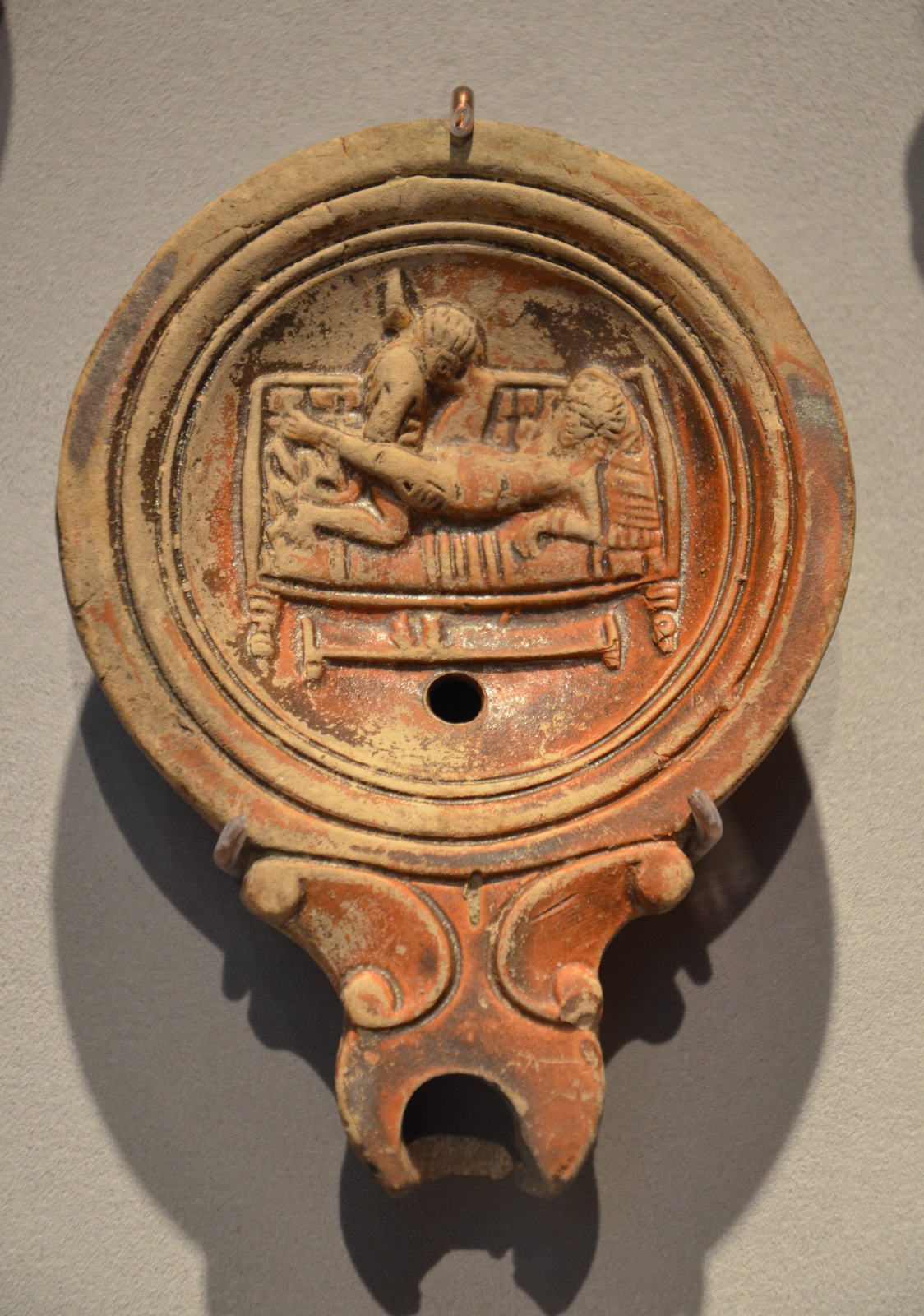Lamp Fragment with Erotic Scene
The lamp fragment in the JHAM is an example of Arretine ware, a relatively inexpensive and popular ceramic ware that was mass-produced in the Roman city of Arretium, modern-day Arezzo, through the use of terracotta and plaster moulds. The decoration on this fragment shows a man and a woman engaged in sexual intercourse. When this lamp was lit, the flame’s flickering light would have animated the figures on the bed. Moreover, the placement of the hole for the wick, just below the bed, is in itself a visual pun. The couple depicted on this lamp is, quite literally, on fire.

To a large extent, Arretine ware replicated the form and decoration of more expensive vessels made in either silver or gold. Arretine ware’s elegant designs and evocation of a de luxe lifestyle made it especially attractive to consumers. Because it was affordable and widely exported, examples of Arrentine ware have been found in relatively modest archaeological contexts across the empire, from Britain to Asia Minor. For these reasons, many scholars understand these objects as products intended for non-elite customers, who nonetheless wanted to stay abreast of current fashions and tastes.
Non-mythological erotic scenes similar to the one depicted on the JHAM fragment appear frequently on a variety of Roman objects intended for daily use. They appear not only on ceramic lamps, but also on silver cups, engraved gemstones, and wall paintings. These images portray a range of settings, couples, and positions with a casualness that is foreign to modern viewers. Both elite and non-elite Roman spectators were, therefore, accustomed to encountering such explicit sexual scenes on every day, domestic objects. Erotic lamps were particularly popular and enjoyed a long life-span in Roman culture. Extant examples date from the 2nd century B.C.E. to the 5th century C.E.

From this evidence, we can deduce that, when purchasing an oil lamp, a large number of customers chose representations of sexual scenes over other available motifs such as mythological representations, images of animals, and abstract floral designs. For the Romans, erotic images such as the one on the JHAM fragment evoked notions of pleasure rather than sin, guilt, or shame. The sexual act represented in these images was, above all, seen as a gift from Venus.
In the Augustan and early Julio-Claudian periods (27 B.C.E. to 30 C.E.) a new style of erotic representation emerged in Roman art. This particular style often marked erotic scenes as domestic and private. Although they first appeared in elite contexts, these “domesticated” erotic images soon became widespread.

For instance, on the terracotta lamp fragment in the JHAM the couple is shown on a bed, in a secluded setting. Great care has been taken to show that the bed is itself a luxury item. By choosing to depict this erotic scene from a bird’s eye view, the artist placed added emphasis on the texture of the fabrics on the bed, whose creases communicated their softness. Such idealized images of sex were then associated with notions of luxury, pleasure, and elite status. The erotic scene on this lamp fragment can, therefore, be seen as representative of Roman attitudes towards sexuality.

Related Post
A shocking documentary proves that mermaids do exist
SHOCKING Revelation: Thuya, Mother of Queen Tiye, Was the Grandmother of Akhenaten and Tutankhamun—What Ancient Egyptian Secrets Did She Leave Behind?
Breaking News: Astonishing Discoveries at Karahan Tepe Confirm an Extraterrestrial Civilization is Hiding on Earth, and NO ONE Knows!
Breaking News: Researchers FINALLY Discover U.S. Navy Flight 19 After 75 Years Lost in the Bermuda Triangle!
NASA’s Secret Investigation: Uncovering the Astonishing Mystery of the UFO Crash on the Mountain!
Explosive UFO Docs LEAKED: Startling Proof That Aliens Ruled Ancient Egypt!
